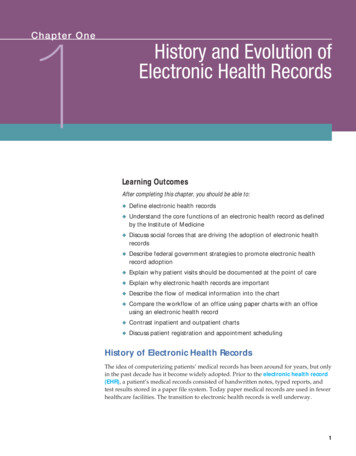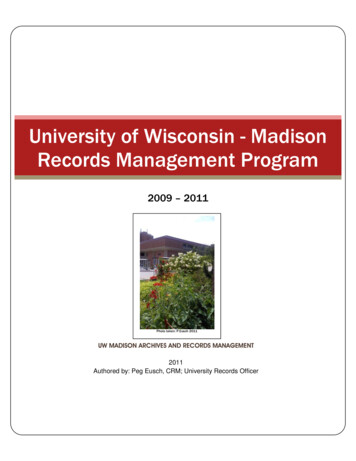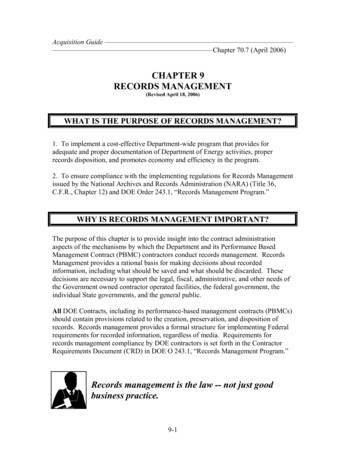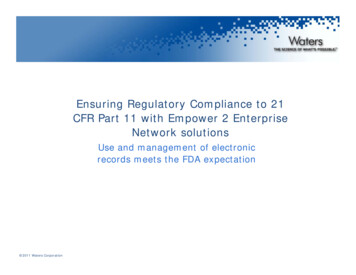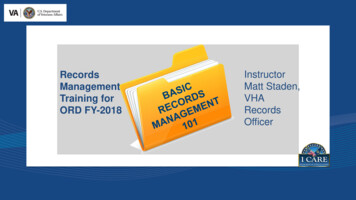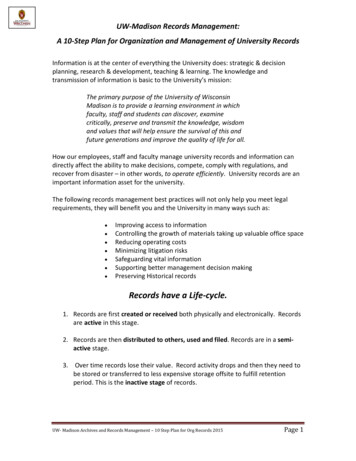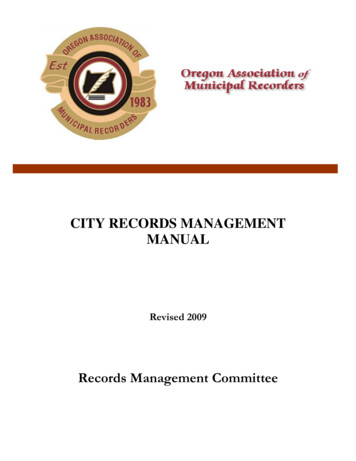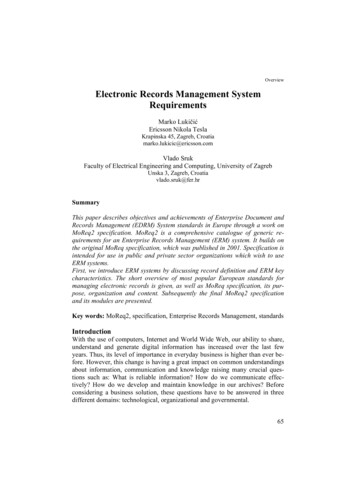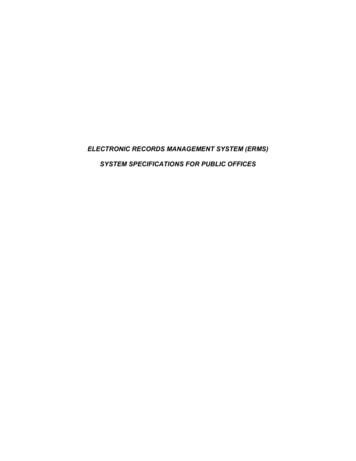
Transcription
ELECTRONIC RECORDS MANAGEMENT SYSTEM (ERMS)SYSTEM SPECIFICATIONS FOR PUBLIC OFFICES
CONTENTS1.INTRODUCTION1.1 Scope1.2 Background1.3 Purpose1.4 Audience1.5 Related standards1.6 Terminology1.7 Structure2.GUIDELINES2.1 What are records and why are they important?2.2 Characteristics of electronic records and electronic recordsmanagement systems2.2.1Supporting import, export and interoperability2.2.2Authentication, encryption and technological protectionmeasures2.3 Overview of functional requirements2.3.1Create2.3.2Maintain2.3.3Use, Access and Dissemination2.3.4Administer2.4 Using the functional requirements set2.4.1Key outcomes2.4.2Obligation levels3FUNCTIONAL REQUIREMENTS3.1 Capture3.1.1Capture processes3.1.2Point of capture metadata3.1.3Aggregation of electronic records3.1.4Bulk importing3.1.5Electronic document formats3.1.6Compound records3.1.7Email3.2 Identification3.3 Classification3.3.1Establishing a classification scheme3.3.2Classification levels3.3.3Classification processes3.3.4Record volumes3.4 Managing authentic and reliable records3.4.1Access and security3.4.2Access controls3.4.3Establishing security control3.4.4Assigning security levels
3.4.5Executing security controls3.4.6Security categories3.4.7Records management process metadata3.4.8Tracking record movement3.5 Hybrid records management3.5.1Management of electronic and non-electronic records3.6 Retention and disposal3.6.1Disposition authorities3.6.2Migration, export and destruction3.6.3Retention and disposal of electronic and non-electronicrecords3.7 Search, retrieve and render3.7.1Rendering: displaying records3.7.2Rendering: printing3.7.3Rendering: redacting records3.7.4Rendering: other3.7.5Rendering: re-purposing content3.8 Administration3.8.1Administrator functions3.8.2Metadata administration3.8.3Reporting3.8.4Back-up and recovery3.9 Multimedia Repository3.9.1Content Creation3.9.2Workflow3.9.3Metadata and Search3.9.4User Interface3.9.5Reporting and Administration3.9.6Security3.10 Enterprise Content Management3.10.1All Software Modules3.10.2Architecture3.10.3Desktop Client3.10.4Security/Access3.10.5Image Capture3.10.6Image Capture Indexing3.10.7Document Management3.10.8Records Management3.10.9Workflow3.10.10 System Administration3.10.11 Fax3.10.12 Printer3.10.13 Web Publishing3.10.14 System3.11 Collaboration Management3.11.1Correction and Creation3.11.2Instant Messaging3.11.3Paging3.11.4Security3.11.5Retention and Disposal
04RetrievalThesaurus SearchRetrieval PresentationCheck-in/Check-out and Editing of Electronic DocumentsAuditingInterfaceWorkflowEmail SystemReplicationKnowledge ManagementTrackingMultimedia SupportVirtual BriefcaseAdditional Functional RequirementNotification ProcessAPPENDICES1Pre-requisites for ERMS Implementation2Glossary
1.INTRODUCTIONGood management of records and information is fundamental to a wellfunctioning organisation since it supports business activity and provides abasis for efficient service delivery. It also provides the mechanism wherebyboth the private and public sectors can account for their decisions andactions. Records provide evidence for the public to confirm or claim theirpublic rights and entitlements, as well as providing individuals with evidenceto justify government decisions and a mechanism whereby they can havetrust in private enterprise. Moreover, good records management is simplygood business practice.Records management systems facilitate: efficiency, by making information readily available when neededfor decision-making and operational activities; sound use of financial resources, by allowing timely disposal ofnon-current records; accountability, by enabling the creation of a complete andauthoritative record of official activities; compliance, by demonstrating that legal requirements havebeen met; and risk mitigation, by managing the risks associated with illegal lossor destruction of records, and from inappropriate orunauthorised access to records.1.1BackgroundThis document is part of the Electronic Records Management System System Specification for Public Offices. The original document wasdeveloped by the National Archives of Malaysia under the First Phase of thee-SPARK project. This new version (version 2) of the System Specificationshas adapted and incorporated all the recommendations from the InternationalCouncil on Archives, Principles and Functional Requirements for Records inElectronic Office Environments Project in which the National Archives ofMalaysia also participated in. This project was aimed at producing globallyharmonized principles and functional requirements for software which is usedto create and manage electronic records in office environments.This document focuses on the creation and management of electronicrecords. It has been arranged with many headings and sub headings forease of understanding and carries clear descriptions as outlined in theInternational Council on Archives, Principles and Functional Requirements forRecords in Electronic Office Environments – Module 2: Guidelines andFunctional Requirements for Electronic Records Management Systems,2008. It is intended for use by the public and the private sector organizationsthat wish to introduce, develop and implement Electronic RecordsManagement System, or to assess the Electronic Records ManagementSystem capability they currently have in place. This is established to ensurethat the electronic records (e-records) generated by the public sector (or the
private sector) can be preserved while maintaining its authenticity, reliability,integrity, usability, and accessibility at any time.1.2ScopeThe scope of this system specification is limited to products that are usuallytermed ‘electronic records management systems’. It does not seek to setrequirements for records still in use within business systems. Digital objectscreated by email, word processing, spreadsheet and imaging applications(such as text documents, and still and moving images), where they areidentified to be of business value, should be managed within electronicrecords management systems that meet the functional requirements in thissystem specification. Records managed by an electronic recordsmanagement system may be stored on a variety of different media formats,and may be managed in hybrid record aggregations that include bothelectronic and non-electronic elements.This system specification does not attempt to include requirements that arenot specific to, or necessary for, records management, for example, generalsystem management and design requirements. Nor does it includerequirements common to all software applications, such as the performance,scalability and usability of the application. Given the target audience of thisdocument, it also assumes a level of knowledge about developing designspecifications, procurement and evaluation processes, and therefore theseissues are not covered in this specification. Although not included in thisspecification’s requirements, the importance of non-records managementfunctional requirements for records management systems is recognisedthrough their inclusion in the high-level model outlined in Section 2.3:Overview of functional requirements.1.3PurposeThis specification articulates a set of functional requirements for electronicrecords management systems. These requirements apply to recordsirrespective of the media in which they were created and stored. They areintended to: explain processes and requirements for identifying andmanaging records in electronic records management systems; develop requirements for records management functionality tobe included in a design specification when building, upgradingor purchasing electronic records management systemssoftware; inform records management functional requirements in theselection of commercially available electronic recordsmanagement systems; and review the records management functionality or assesscompliance of existing electronic records management systems.This specification is a revised version of the original document which wasdeveloped by the National Archives of Malaysia under the First Phase of the
e-SPARK project.This version has adapted and incorporatedrecommendations from the International Council on Archives, Principles andFunctional Requirements for Records in Electronic Office Environments :Module 2 - Guidelines and Functional Requirements for Electronic RecordsManagement Systems and is designed to: assist organisations to improve electronic records managementpractices; reduce the duplication of effort and associated costs inidentifying minimum level of records management functionalityfor electronic records management systems; and establish greater standardisation of records managementrequirements for software vendors across different jurisdictions.1.4AudienceThe primary audience for this document is: by potential ERMS users: as a basis for preparing an invitationto tender;by ERMS users: as a basis for auditing or checking an existingERMS;by training organizations: as a reference document forpreparing records management training, and as course material;by academic institutions: as a teaching resource;by ERMS suppliers and developers: to guide productdevelopment by highlighting functionality required;by record management service providers: to guide the natureof the services to be provided;by potential users of outsourced record managementservices: as an aid in specifying the services to be procured.This document has minimised the usage of specific records managementterminology. Where the use of such terminology is necessary, definitions canbe found in the Glossary at Appendix 2.1.5Related standardsThe requirements in this system specifications are aligned with the recordsmanagement principles in ISO 15489 Information and Documentation –Records Management – Part 1: General, which sets out the recordsmanagement requirements that also apply when records are captured andmanaged within electronic records management systems.The reference metadata standard for these requirements is ISO 23081 – 1:2006, Information and Documentation – Records Management Processes –Metadata for Records, Part 1 – Principles. The high-level metadata elementset found in ISO/TS 23081 – 2: 2007, Information and Documentation –Records Management Processes – Metadata for Records, Part 2 –Conceptual and Implementation Issues provides the basis for therequirements in this system specifications.
The requirements presented in this system specification are core, high-leveland generic requirements for records. Readers seeking guidance in otherareas of software functionality not addressed in this Module can refer to othermore detailed specifications such as US DoD 5015.2 and MoReq2.1.6TerminologyMany of the terms used in this document have differing definitions acrossdisciplines. For example, the term ‘archive’ may mean a storage of little-useddata in a database to an IT audience, whereas it means the retention of fixedappraised information no longer retained for current business use within therecords management discipline. It is therefore important that this document isread in conjunction with the Glossary at Appendix A. A number of the centralconcepts used in this document are also outlined below, to avoidmisinterpretation: Records – information created, received and maintained as evidenceand information by an organisation or person, in pursuance of legalobligations or in the transaction of business.1 They provide evidence ofbusiness transactions and can exist in any format. Records management – the control of the creation, receipt,maintenance, use and disposal of records in accordance with professionaland international standards of practice. Records management is distinct fromdocument management, which is typically concerned with the provision ofaccess, collaborative working and version control of documents, rather thanthe management of authenticity, reliability, integrity and usability over time. Electronic records management systems (commonly referred to asEDRMS or ERMS) – systems specifically designed to manage themaintenance and disposition of records. They maintain the content, context,structure and links between records to enable their accessibility and supporttheir value as evidence. Electronic records management systems aredistinguished from business systems, for the purpose of this document,because their primary function is the management of records. Business systems – automated systems that create or manage dataabout an organisation’s activities (for the purpose of this document). Theyinclude applications whose primary purpose is to facilitate transactionsbetween an organisational unit and its customers, for example, an ecommerce system client-relationship management system, purpose-built orcustomised database, and finance or human resources systems. Businesssystems typically contain dynamic data that is commonly subject to constantupdates (timely), able to be transformed (manipulable) and holds current data(non- redundant). For the purpose of this document, business systemsexclude electronic records management systems.1International Standard on Records Management, ISO 15489.
System – use of the term ’system’ in this document refers to acomputer or IT system. This is in contrast to the records managementunderstanding of the term, which encompasses the broader aspects ofpeople, policies, procedures and practices. While the focus of this Module isprimarily electronic records management systems software, organisations willneed to pay attention to wider aspects of records management frameworks,policies and tools to ensure records can be appropriately managed. Forexample, fundamentalrecords management tools, such as dispositionauthorities and information security classifications, must be in place andoperate within an established records management culture within theorganisation. A system may comprise more than one application and includeplug-ins Records management metadata – an inextricable part of recordsmanagement, serving a variety of functions and purposes. In a recordsmanagement context, metadata is defined as data describing the context,content and structure of records and their management through time (ISO15489 – 1: 2001, 3.12). As such, metadata is structured or semi-structuredinformation that enables the creation, registration, classification, access,preservation and disposition of records through time and within and acrossdomains. Records management metadata can be used to identify,authenticate and contextualise records and the people, processes andsystems that create, manage, maintain and use them, and the policies thatgovern them. Initially, metadata defines the record at its point of capture,fixing the record into its business context and establishing managementcontrol over it. During the existence of records or their aggregates, new layersof metadata will be added because of new roles in other business or usagecontexts. This means that metadata continues to accrue information relatingto the context of the records management and the business processes inwhich the records are used, and to structural changes to the record or itsappearance.Metadata can be sourced or re-used by multiple systems and for multiplepurposes. Metadata applied to records during their active life may alsocontinue to apply when the records cease to be required for current businesspurposes but are retained for ongoing research or other values. The purposeof records management metadata is to ensure authenticity, reliability, usabilityand integrity over time, and to enable the management and understanding ofinformation objects, whether these are physical, analogue or electronic.However, metadata also needs to be managed as a record or as acomponent of a record.Records management has always involved the management of metadata.However, the electronic environment requires a different expression oftraditional requirements and different mechanisms for identifying, capturing,attributing and using metadata. In the electronic environment, authoritativerecords are those accompanied by metadata defining their criticalcharacteristics. These characteristics must be explicitly documented ratherthan being implicit, as in some paper-based processes.
2GUIDELINES2.1What are records and why are they important?Records are a valuable business asset. One of the key ways organisationsare held accountable for their actions is through evidence of businesstransactions in the form of records. Records are ‘information created,received, and maintained as evidence and information, by an organisation orperson, in pursuance of legal obligations or in the transaction of business’. 2They must be retained for a period of time that is in line with an authorisedretention schedule or disposition authority, sometimes referred to as a‘disposition’.A record is not just a collection of data, but is the consequence or product ofan event and therefore linked to business activities. A distinguishing feature ofrecords is that their content must exist in a fixed form, that is, be a fixedrepresentation of the business transaction. Managing records in businesssystems, which contain data that is frequently updated and dynamic, isparticularly challenging and may provide a rationale for implementing aseparate electronic records management system. Records comprise not onlycontent but also information about the context and structure of the record.Records management metadata ‘identifies, authenticates and contextualisesrecords and the people, processes and systems that create, manage,maintain and use them and the policies that govern them.’ 3 It allows recordsto be located, rendered and understood in a meaningful way. ISO/TS 23081 –2 provides a generic statement of records management metadata elements.Organisations may also have jurisdiction-specific elements sets to which theymust adhere.An appropriately managed record will provide a basis for: transparent, informed and quality decision-making and planning; an information resource that can be used to demonstrate andaccount for organisational activities; and consistency, continuity and efficiency in administration andmanagement.The International Standard on Records Management, ISO 15489, providesbest- practice guidance on how records should be managed to ensure theyare authentic, reliable, complete, unaltered and usable. Organisations that donot employ an electronic records management system may risk loss of keyevidence of their business activities, thereby resulting in a lack of corporatememory, inefficiency and an inability to meet accountability and legislativerequirements. The risks of not implementing an electronic recordsmanagement system are: failure to meet legislative and regulatory requirements;23International Standard on Records Management, ISO 15489International Standard on Information and Documentation – Records Management Processes –Metadata for Records, ISO 23081.
embarrassment to your chief executive, the government and/orprivate individuals, especially if inability to manage informationcompetently is highlighted in the media;poor strategic planning and poor decisions based on inaccurateinformation;business critical information not accessible for the conduct ofbusiness, dispute resolution, legal challenge or evidentialpurposes;loss of credibility, lowered public confidence, or financial orlegislative penalties through inability to produce records orprovide evidence of business activity when required in a timelymanner;inability to provide evidence of the organisation’s activities orundertakings with external agencies, clients or contractors;inconsistent and inefficient conduct of business;inability to exploit organisational information and knowledge tofull potential;unlawful disposal of records and inability to fully exploitcorporate knowledge and data;duplication of effort, and poor resource and asset management;reduced capability of demonstrating good performance and anyincreased efficiencies or improved service delivery; andorganisational embarrassment and damage to reputation.The benefits of good recordkeeping include: protection and support in litigation, including the management ofrisks associated with the existence or lack of evidence oforganisational activity; protection of the interests of the organisation and the rights ofemployees, clients, and present and future stakeholders; improved security of business records and robust managementof commercial-in-confidence, personally sensitive or confidentialinformation; the ability to deliver services in an efficient and consistentmanner; ability to support current and future research and developmentactivities; improved comprehensiveness and reliability of corporatememory; availability of relevant business activity records when required tosupport well-informed decision-making and policy development; reduced risk of data loss or accidental destruction of records; reliable performance measurement of business outputs; increased public and/or client confidence in the integrity of anorganisation’s activities; and identification of vital records for disaster planning, so thatorganisations can continue to function in the event of severedisruption.
Authoritative and credible recordkeeping is an essential component of goodgovernance and for underpinning reliable and consistent business practiceand service delivery.2.2Characteristics of electronic records and electronic recordsmanagement systemsOnce records have been created, they must be managed and maintained foras long as required to ensure they have the following characteristics:4 Authenticity – the record can be proven to be what it purports to be, tohave been created or sent by the person that created or sent it, and tohave been created or sent at the time it is purported to have occurred. Reliability – the record can be trusted as a full and accuraterepresentation of the transaction(s) to which they attest, and can bedepended on in the course of subsequent transactions. Integrity – the record is complete and unaltered, and protected againstunauthorised alteration. This characteristic is also referred to as‘inviolability’. Usability – the record can be located, retrieved, preserved andinterpreted.Typically, electronic records management systems have the followingattributes that seek to ensure these characteristics are maintained: Creating records in context – electronic records managementsystems enable organisations to capture evidence of their businessactivity. This involves identifying a set of electronic information to serveas the evidential record comprising both content and context. So, inorder for information to have the capability of functioning as a record, itis necessary to augment that content information with additional data(that is, metadata) that places it in the context of the businessoperations and computing environment in which it was created. Managing and maintaining records – electronic records have to beactively managed as evidence of business activity, and to maintaintheir authenticity, reliability, integrity and usability. Maintenance of thisevidence, as records, is necessary for operational viability andaccountability of the organisation. Maintaining records for as long as they are required – recordsmust be retained for a period of time that is in accordance withauthorised legislative and jurisdictional requirements. Decisions about4These are taken from ISO 15489.1 Records Management, Section 7.2 Characteristics ofrecords.
how long records must be retained are defined in disposition/disposalpolicies and rules. There will be some records that must be retainedpermanently while others will be required to be retained for varyingperiods or have a maximum retention period (for example, for privacyor data-protection legislative purposes).Records have to be able to be disposed of in a managed, systematicand auditable way. A hallmark of appropriate records management isthe retention and appropriate disposition of records according tospecified rules as stated in Section 27 of National Archives Act 2003.Systems need to be able to delete records in a systematic, auditableand accountable way in line with operational and juridicalrequirements. Organisations will need to meet the policies andprocedures of their local jurisdictional authority for identifying, retainingand disposing of records. Records management metadata can be configured – to bemeaningful as evidence of a business process, records must be linkedto the context of their creation and use. To do this, the record must beassociated with metadata about the business context in a classificationstructure. In addition to this ‘classification’ metadata, other metadatathat should be captured at the point of creation includes:-record identifier (as specified in the e-file plan);date of creation;creator/author/person responsible; andthe business being conductedetcMuch of this information can be automatically generated. In thisSpecification, integration of metadata for managing records isaddressed at a relatively high level. Rather than specifically detailingevery metadata element required, the functional requirements setinstead provides broad references to the need to have functionality thatis capable of creating, capturing and maintaining adequate metadataelements. It is expected that each organisation will capture recordsmanagement metadata in line with an identified records managementmetadata standard, in accordance with organisational and/orjurisdictional requirements, and/or be consistent with ISO 23081 – 1:2006, Information and Documentation – Records ManagementProcesses – Metadata for Records, Part 1 – Principles; and ISO/TS23081 – 2: 2007, Information and Documentation – RecordsManagement Processes – Metadata for Records, Part 2 – Conceptualand Implementation Issues. Records can be reassigned or reclassified, closed and ifrequired, duplicated and extracted – the identification of needs forrecords should establish at what point in the process a record shouldbe created. Any further Processes that happen to the record after this
point must result in the creation of a new record or the recordedaugmentation/versioning of the existing record, rather than alteration toit. This means that content and metadata that need to be kept to recordprevious decisions or processes cannot be overwritten, but that newcontent or metadata can be added.It is important to ensure that the system is not ‘locked down’ to such anextent that simple mistakes (such as mistyping a name) cannot becorrected – although permission for changes may be restricted to asystem administrator or prevented by the system in exceptionalcircumstances, such as pending legal action. Reports can be undertaken – on records and the managementthereof. Security processes can be put in place – normal systems controlsover access and security support the maintenance of authenticity,reliability, integrity and usability, and therefore should be appropriatelydocumented.A risk assessment can inform business decisions as to how rigorousthe controls need to be. For example, in a high-risk environment, it maybe necessary to prove exactly what happened, when and by whom.This links to systems permissions and audit logging, to prove thatapproved actions are undertaken by authorised users. Userrequirements should be assigned at appropriate levels of access by anadministrator.Table 1: System levels of accessUserAuthorised userRecordsadministrator(or recordsmanager)Systemadministrator (IT)Any person with permission to access the electronic recordsmanagement system. That is, anyone who creates, receives,reviews and/or uses records stored in the system. This is thestandard level of access that most employees of anorganisation will possess.A user with special access permissions that allow additionalaccess to, and/or control over, records contained in theelectronic records management system. Authorised usersmay in some instances be assigned permissions to undertaketasks similar to those of the system administrator, such as theability to close and re-open records, create extracts ofrecords and edit record metadata. The powers assigned toauthorised users will vary depending on the business needsof the organisation and the level of responsibility allotted tothe authorised userA system administrator, usually the records manager, withdesignated responsibility for configuring, monitoring andmanaging the electronic records management system contentand its use.A person with responsibility for assigning and removing thepermissions allocated to users and authorised users.
2.2.1 Supporting import, export and interoperabilityThe ability to import and export records, and interoperability with othersystems, is frequently required functionality. Records may need to beexported to other organisations in the event of mergers or government reorganisational changes.Many records may need to be retained for longer than the lifespan of thesoftware system itself, and therefore there is a need to be able to exportrecords when transitioning to a new electronic records management system.There may also be a need to import records from business systems,particularly in collaborative business environments.For ease of import and export, use of open formats and industry standardswill increase levels of interoperability and reduce the cost and difficulty of anyimport/export process.This functionality must be addressed at the planning stages as part of thebusiness requirements.2.2.2 rotectionThese issues have an impact on the reliability of records issue. Electronicrecords management systems must allow records to be effectively managedwhen they have been subject to technological protection measures, electronicsignatures an
3.10.7 Document Management 3.10.8 Records Management 3.10.9 Workflow 3.10.10 System Administration 3.10.11 Fax 3.10.12 Printer 3.10.13 Web Publishing 3.10.14 System 3.11 Collaboration Management . records management systems that meet the functional requirements in this system specification. Records managed by an electronic records

